[English] 日本語
 Yorodumi
Yorodumi- PDB-6mpx: Twelve chloride ions induce formation and stabilize the NC1 hexam... -
+ Open data
Open data
- Basic information
Basic information
| Entry | Database: PDB / ID: 6mpx | |||||||||
|---|---|---|---|---|---|---|---|---|---|---|
| Title | Twelve chloride ions induce formation and stabilize the NC1 hexamer of collagen IV assembled from transition state trimers | |||||||||
 Components Components | fusion protein of non-collagenous domains of collagen type IV | |||||||||
 Keywords Keywords |  STRUCTURAL PROTEIN STRUCTURAL PROTEIN | |||||||||
| Function / homology |  Function and homology information Function and homology informationcollagen type IV trimer / retinal blood vessel morphogenesis / Anchoring fibril formation / renal tubule morphogenesis / Crosslinking of collagen fibrils / Collagen chain trimerization / extracellular matrix structural constituent conferring tensile strength /  platelet-derived growth factor binding / basement membrane organization / Extracellular matrix organization ...collagen type IV trimer / retinal blood vessel morphogenesis / Anchoring fibril formation / renal tubule morphogenesis / Crosslinking of collagen fibrils / Collagen chain trimerization / extracellular matrix structural constituent conferring tensile strength / platelet-derived growth factor binding / basement membrane organization / Extracellular matrix organization ...collagen type IV trimer / retinal blood vessel morphogenesis / Anchoring fibril formation / renal tubule morphogenesis / Crosslinking of collagen fibrils / Collagen chain trimerization / extracellular matrix structural constituent conferring tensile strength /  platelet-derived growth factor binding / basement membrane organization / Extracellular matrix organization / Collagen biosynthesis and modifying enzymes / Laminin interactions / collagen-activated tyrosine kinase receptor signaling pathway / Signaling by PDGF / NCAM1 interactions / Scavenging by Class A Receptors / blood vessel morphogenesis / extracellular matrix structural constituent / Assembly of collagen fibrils and other multimeric structures / branching involved in blood vessel morphogenesis / neuromuscular junction development / endodermal cell differentiation / Collagen degradation / Non-integrin membrane-ECM interactions / platelet-derived growth factor binding / basement membrane organization / Extracellular matrix organization / Collagen biosynthesis and modifying enzymes / Laminin interactions / collagen-activated tyrosine kinase receptor signaling pathway / Signaling by PDGF / NCAM1 interactions / Scavenging by Class A Receptors / blood vessel morphogenesis / extracellular matrix structural constituent / Assembly of collagen fibrils and other multimeric structures / branching involved in blood vessel morphogenesis / neuromuscular junction development / endodermal cell differentiation / Collagen degradation / Non-integrin membrane-ECM interactions /  basement membrane / ECM proteoglycans / Integrin cell surface interactions / cellular response to transforming growth factor beta stimulus / epithelial cell differentiation / extracellular matrix organization / negative regulation of angiogenesis / response to activity / cellular response to amino acid stimulus / basement membrane / ECM proteoglycans / Integrin cell surface interactions / cellular response to transforming growth factor beta stimulus / epithelial cell differentiation / extracellular matrix organization / negative regulation of angiogenesis / response to activity / cellular response to amino acid stimulus /  brain development / collagen-containing extracellular matrix / brain development / collagen-containing extracellular matrix /  angiogenesis / molecular adaptor activity / angiogenesis / molecular adaptor activity /  endoplasmic reticulum lumen / DNA-templated transcription / endoplasmic reticulum lumen / DNA-templated transcription /  extracellular space / extracellular exosome / extracellular region extracellular space / extracellular exosome / extracellular regionSimilarity search - Function | |||||||||
| Biological species |   Homo sapiens (human) Homo sapiens (human) | |||||||||
| Method |  X-RAY DIFFRACTION / X-RAY DIFFRACTION /  SYNCHROTRON / SYNCHROTRON /  MOLECULAR REPLACEMENT / Resolution: 1.9 Å MOLECULAR REPLACEMENT / Resolution: 1.9 Å | |||||||||
 Authors Authors | Bauer, R. / Boudko, S.P. / Hudson, B.G. | |||||||||
| Funding support |  United States, 2items United States, 2items
| |||||||||
 Citation Citation |  Journal: J.Biol.Chem. / Year: 2019 Journal: J.Biol.Chem. / Year: 2019Title: A chloride ring is an ancient evolutionary innovation mediating the assembly of the collagen IV scaffold of basement membranes. Authors: Pedchenko, V. / Bauer, R. / Pokidysheva, E.N. / Al-Shaer, A. / Forde, N.R. / Fidler, A.L. / Hudson, B.G. / Boudko, S.P. | |||||||||
| History |
|
- Structure visualization
Structure visualization
| Structure viewer | Molecule:  Molmil Molmil Jmol/JSmol Jmol/JSmol |
|---|
- Downloads & links
Downloads & links
- Download
Download
| PDBx/mmCIF format |  6mpx.cif.gz 6mpx.cif.gz | 290 KB | Display |  PDBx/mmCIF format PDBx/mmCIF format |
|---|---|---|---|---|
| PDB format |  pdb6mpx.ent.gz pdb6mpx.ent.gz | 228.8 KB | Display |  PDB format PDB format |
| PDBx/mmJSON format |  6mpx.json.gz 6mpx.json.gz | Tree view |  PDBx/mmJSON format PDBx/mmJSON format | |
| Others |  Other downloads Other downloads |
-Validation report
| Arichive directory |  https://data.pdbj.org/pub/pdb/validation_reports/mp/6mpx https://data.pdbj.org/pub/pdb/validation_reports/mp/6mpx ftp://data.pdbj.org/pub/pdb/validation_reports/mp/6mpx ftp://data.pdbj.org/pub/pdb/validation_reports/mp/6mpx | HTTPS FTP |
|---|
-Related structure data
| Related structure data |  1li1S S: Starting model for refinement |
|---|---|
| Similar structure data |
- Links
Links
- Assembly
Assembly
| Deposited unit | 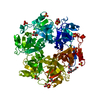
| ||||||||
|---|---|---|---|---|---|---|---|---|---|
| 1 | 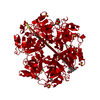
| ||||||||
| Unit cell |
|
- Components
Components
-Protein , 1 types, 1 molecules A
| #1: Protein |  / Collagen alpha-2(IV) chain / Collagen alpha-1(IV) chain / Collagen alpha-2(IV) chain / Collagen alpha-1(IV) chainMass: 76309.609 Da / Num. of mol.: 1 Source method: isolated from a genetically manipulated source Source: (gene. exp.)   Homo sapiens (human) / Gene: COL4A1, COL4A2 / Production host: Homo sapiens (human) / Gene: COL4A1, COL4A2 / Production host:   Cricetulus griseus (Chinese hamster) / References: UniProt: P02462, UniProt: P08572 Cricetulus griseus (Chinese hamster) / References: UniProt: P02462, UniProt: P08572 |
|---|
-Non-polymers , 7 types, 461 molecules 

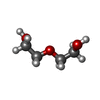
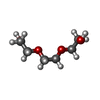
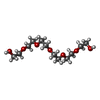








| #2: Chemical | ChemComp-CL /  Chloride Chloride#3: Chemical | ChemComp-SO4 /  Sulfate Sulfate#4: Chemical | ChemComp-PEG / |  Diethylene glycol Diethylene glycol#5: Chemical | ChemComp-PGE / |  Polyethylene glycol Polyethylene glycol#6: Chemical | ChemComp-P6G / |  Polyethylene glycol Polyethylene glycol#7: Chemical | ChemComp-GOL /  Glycerol Glycerol#8: Water | ChemComp-HOH / |  Water Water |
|---|
-Experimental details
-Experiment
| Experiment | Method:  X-RAY DIFFRACTION / Number of used crystals: 1 X-RAY DIFFRACTION / Number of used crystals: 1 |
|---|
- Sample preparation
Sample preparation
| Crystal | Density Matthews: 2.55 Å3/Da / Density % sol: 51.75 % / Mosaicity: 0.63 ° |
|---|---|
Crystal grow | Temperature: 298 K / Method: vapor diffusion, hanging drop / pH: 7.5 Details: .085 M HEPES (pH 7.5), 1.68 M ammonium sulfate, and 1.5% (w/v) PEG 400 |
-Data collection
| Diffraction | Mean temperature: 100 K / Serial crystal experiment: N | |||||||||||||||||||||||||||||||||||||||||||||||||||||||||||||||||||||||||||||||||||||||||||||||||||
|---|---|---|---|---|---|---|---|---|---|---|---|---|---|---|---|---|---|---|---|---|---|---|---|---|---|---|---|---|---|---|---|---|---|---|---|---|---|---|---|---|---|---|---|---|---|---|---|---|---|---|---|---|---|---|---|---|---|---|---|---|---|---|---|---|---|---|---|---|---|---|---|---|---|---|---|---|---|---|---|---|---|---|---|---|---|---|---|---|---|---|---|---|---|---|---|---|---|---|---|---|
| Diffraction source | Source:  SYNCHROTRON / Site: SYNCHROTRON / Site:  APS APS  / Beamline: 21-ID-G / Wavelength: 0.9786 Å / Beamline: 21-ID-G / Wavelength: 0.9786 Å | |||||||||||||||||||||||||||||||||||||||||||||||||||||||||||||||||||||||||||||||||||||||||||||||||||
| Detector | Type: RAYONIX MX-300 / Detector: CCD / Date: Mar 16, 2018 | |||||||||||||||||||||||||||||||||||||||||||||||||||||||||||||||||||||||||||||||||||||||||||||||||||
| Radiation | Monochromator: C(111) / Protocol: SINGLE WAVELENGTH / Monochromatic (M) / Laue (L): M / Scattering type: x-ray | |||||||||||||||||||||||||||||||||||||||||||||||||||||||||||||||||||||||||||||||||||||||||||||||||||
| Radiation wavelength | Wavelength : 0.9786 Å / Relative weight: 1 : 0.9786 Å / Relative weight: 1 | |||||||||||||||||||||||||||||||||||||||||||||||||||||||||||||||||||||||||||||||||||||||||||||||||||
| Reflection | Resolution: 1.9→85.673 Å / Num. all: 62515 / Num. obs: 62515 / % possible obs: 99.9 % / Redundancy: 8.9 % / Biso Wilson estimate: 28.9 Å2 / Rpim(I) all: 0.041 / Rrim(I) all: 0.129 / Rsym value: 0.122 / Net I/av σ(I): 3.6 / Net I/σ(I): 9.5 / Num. measured all: 558146 | |||||||||||||||||||||||||||||||||||||||||||||||||||||||||||||||||||||||||||||||||||||||||||||||||||
| Reflection shell | Diffraction-ID: 1
|
- Processing
Processing
| Software |
| ||||||||||||||||||||||||||||||||||||||||||||||||||||||||||||||||||||||||||||||||||||||||||||||||||||||||||||||||||||||||||||||||||||||||||||||||||||||||||||||||||||||||
|---|---|---|---|---|---|---|---|---|---|---|---|---|---|---|---|---|---|---|---|---|---|---|---|---|---|---|---|---|---|---|---|---|---|---|---|---|---|---|---|---|---|---|---|---|---|---|---|---|---|---|---|---|---|---|---|---|---|---|---|---|---|---|---|---|---|---|---|---|---|---|---|---|---|---|---|---|---|---|---|---|---|---|---|---|---|---|---|---|---|---|---|---|---|---|---|---|---|---|---|---|---|---|---|---|---|---|---|---|---|---|---|---|---|---|---|---|---|---|---|---|---|---|---|---|---|---|---|---|---|---|---|---|---|---|---|---|---|---|---|---|---|---|---|---|---|---|---|---|---|---|---|---|---|---|---|---|---|---|---|---|---|---|---|---|---|---|---|---|---|
| Refinement | Method to determine structure : :  MOLECULAR REPLACEMENT MOLECULAR REPLACEMENTStarting model: 1LI1 Resolution: 1.9→39.893 Å / SU ML: 0.18 / Cross valid method: THROUGHOUT / σ(F): 1.33 / Phase error: 16.77
| ||||||||||||||||||||||||||||||||||||||||||||||||||||||||||||||||||||||||||||||||||||||||||||||||||||||||||||||||||||||||||||||||||||||||||||||||||||||||||||||||||||||||
| Solvent computation | Shrinkage radii: 0.9 Å / VDW probe radii: 1.11 Å | ||||||||||||||||||||||||||||||||||||||||||||||||||||||||||||||||||||||||||||||||||||||||||||||||||||||||||||||||||||||||||||||||||||||||||||||||||||||||||||||||||||||||
| Displacement parameters | Biso max: 101.23 Å2 / Biso mean: 35.159 Å2 / Biso min: 17.01 Å2 | ||||||||||||||||||||||||||||||||||||||||||||||||||||||||||||||||||||||||||||||||||||||||||||||||||||||||||||||||||||||||||||||||||||||||||||||||||||||||||||||||||||||||
| Refinement step | Cycle: final / Resolution: 1.9→39.893 Å
| ||||||||||||||||||||||||||||||||||||||||||||||||||||||||||||||||||||||||||||||||||||||||||||||||||||||||||||||||||||||||||||||||||||||||||||||||||||||||||||||||||||||||
| LS refinement shell | Refine-ID: X-RAY DIFFRACTION / Rfactor Rfree error: 0 / Total num. of bins used: 23
| ||||||||||||||||||||||||||||||||||||||||||||||||||||||||||||||||||||||||||||||||||||||||||||||||||||||||||||||||||||||||||||||||||||||||||||||||||||||||||||||||||||||||
| Refinement TLS params. | Method: refined / Origin x: 20.6292 Å / Origin y: 24.2647 Å / Origin z: 17.6963 Å
| ||||||||||||||||||||||||||||||||||||||||||||||||||||||||||||||||||||||||||||||||||||||||||||||||||||||||||||||||||||||||||||||||||||||||||||||||||||||||||||||||||||||||
| Refinement TLS group | Selection details: (chain A and resseq 4:676) |
 Movie
Movie Controller
Controller


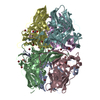
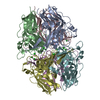
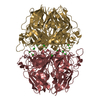
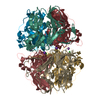
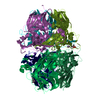
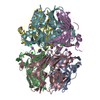
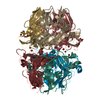
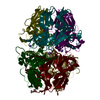
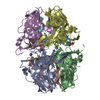
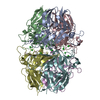
 PDBj
PDBj




















